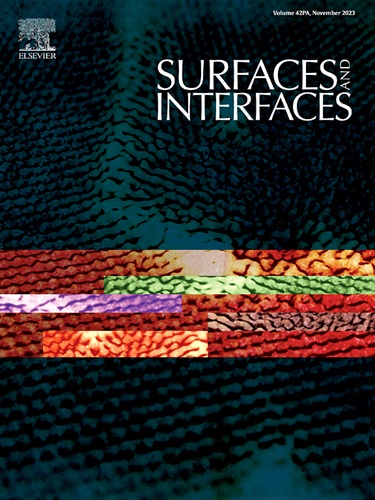Rear interface point contact passivation of Cu(In,Ga)Se2 thin film solar cells by Al2O3 nanoparticles
IF 5.7
2区 材料科学
Q2 CHEMISTRY, PHYSICAL
引用次数: 0
Abstract
To form a rear interface point contact passivation structure for Cu(In,Ga)Se2 (CIGS) thin-film solar cells, Al2O3 nanoparticles with different coverage were fabricated at the interface between CIGS and Mo film by low-cost solution method, and the passivation mechanism was investigated systematically. Based on a series of tests, the device performance improvement mainly came from the increase of short circuit current density (JSC), resulting from the reflection enhancement by Al2O3 particles at the CIGS/Mo interface, which promotes the light absorption by CIGS film. In addition, the effect on the three-step co-evaporation process led to a red shift in the absorption limit, thereby increasing the quantum efficiency. Further, Al2O3 particles buried at the rear interface exhibited more negative potential than the uncovered locations, which inhibits the diffusion of minority carriers toward the rear interface and decreases the recombination of carriers. In summary, the local passivation near the rear interface brings an absolute efficiency increase of 0.75 % over the average efficiency of the reference cell, and a 17.76 % efficient solar cell was fabricated with an optimal coverage of Al2O3 particles.

Al2O3纳米颗粒后界面点接触钝化Cu(In,Ga)Se2薄膜太阳电池
为了形成Cu(In,Ga)Se2 (CIGS)薄膜太阳电池的后界面点接触钝化结构,采用低成本溶液法制备了不同覆盖度的Al2O3纳米颗粒,并对其钝化机理进行了系统研究。通过一系列的测试,器件性能的提高主要来自于短路电流密度(JSC)的增加,这是由于Al2O3颗粒在CIGS/Mo界面处的反射增强,促进了CIGS膜的光吸收。此外,对三步共蒸发过程的影响导致了吸收极限的红移,从而提高了量子效率。埋在后界面的Al2O3颗粒比未埋界面的Al2O3颗粒表现出更多的负电位,这抑制了少量载流子向后界面的扩散,降低了载流子的复合。综上所述,后界面附近的局部钝化使太阳能电池的绝对效率比基准电池的平均效率提高了0.75%,制备出了具有最佳Al2O3颗粒覆盖的效率为17.76%的太阳能电池。
本文章由计算机程序翻译,如有差异,请以英文原文为准。
求助全文
约1分钟内获得全文
求助全文
来源期刊

Surfaces and Interfaces
Chemistry-General Chemistry
CiteScore
8.50
自引率
6.50%
发文量
753
审稿时长
35 days
期刊介绍:
The aim of the journal is to provide a respectful outlet for ''sound science'' papers in all research areas on surfaces and interfaces. We define sound science papers as papers that describe new and well-executed research, but that do not necessarily provide brand new insights or are merely a description of research results.
Surfaces and Interfaces publishes research papers in all fields of surface science which may not always find the right home on first submission to our Elsevier sister journals (Applied Surface, Surface and Coatings Technology, Thin Solid Films)
 求助内容:
求助内容: 应助结果提醒方式:
应助结果提醒方式:


